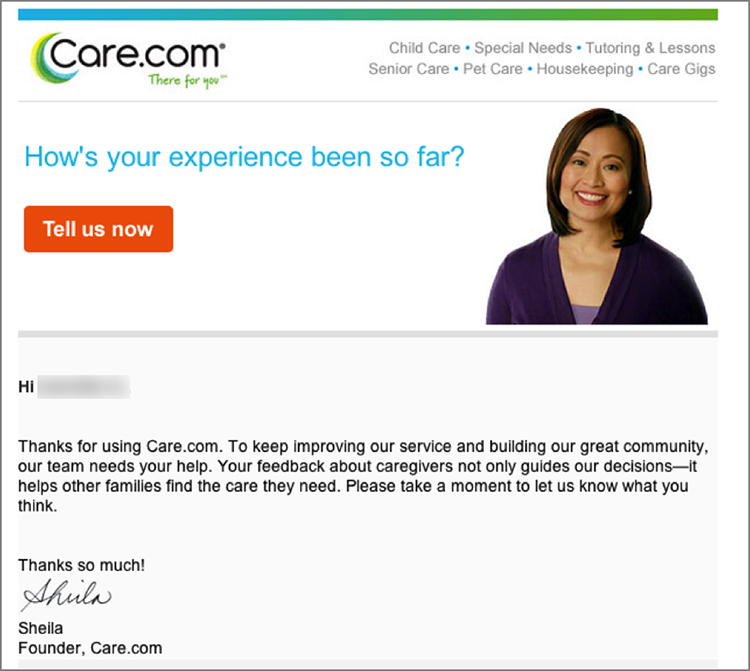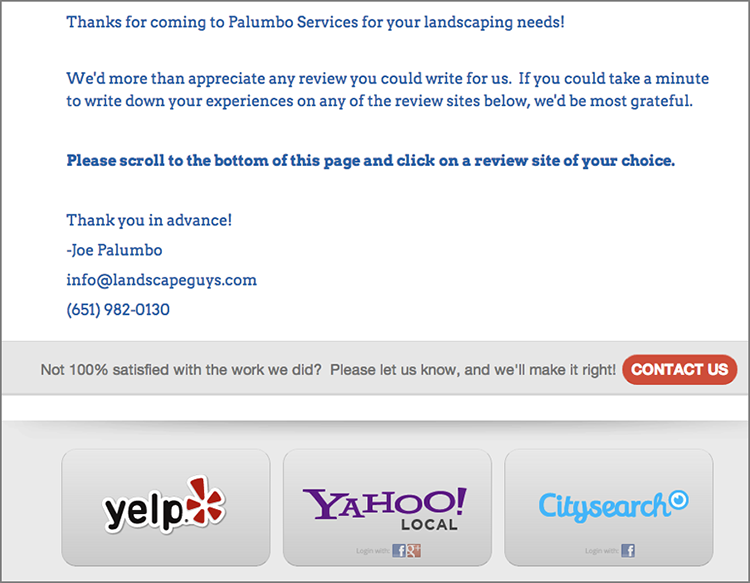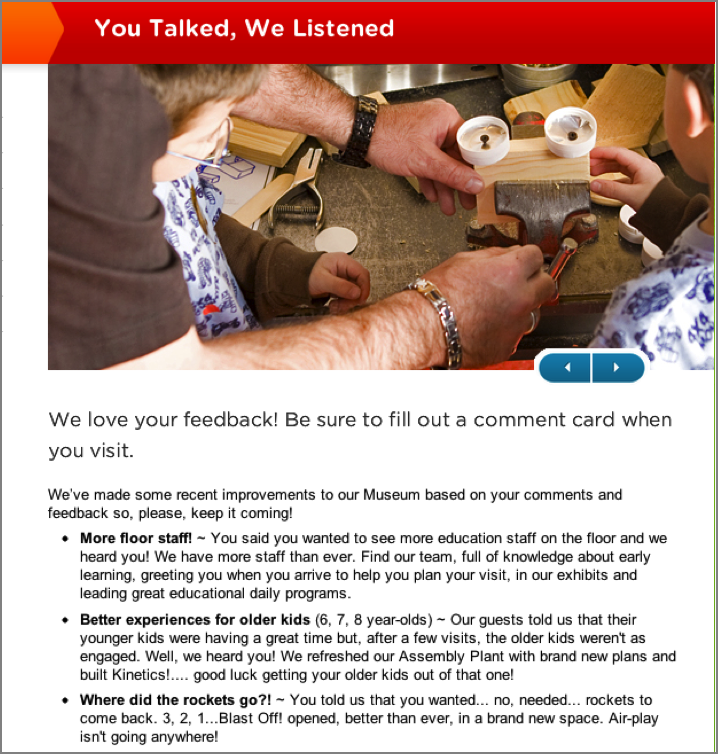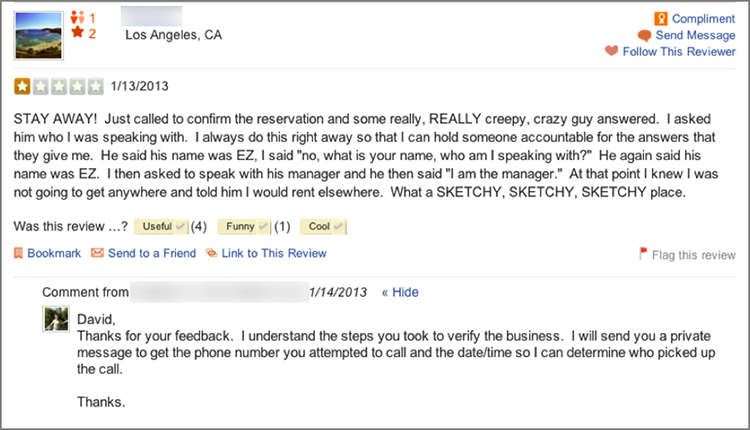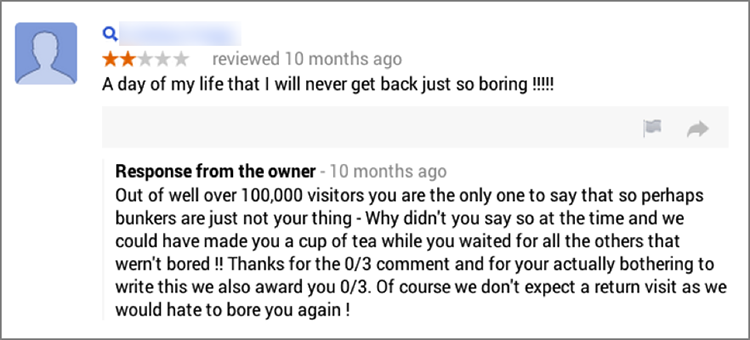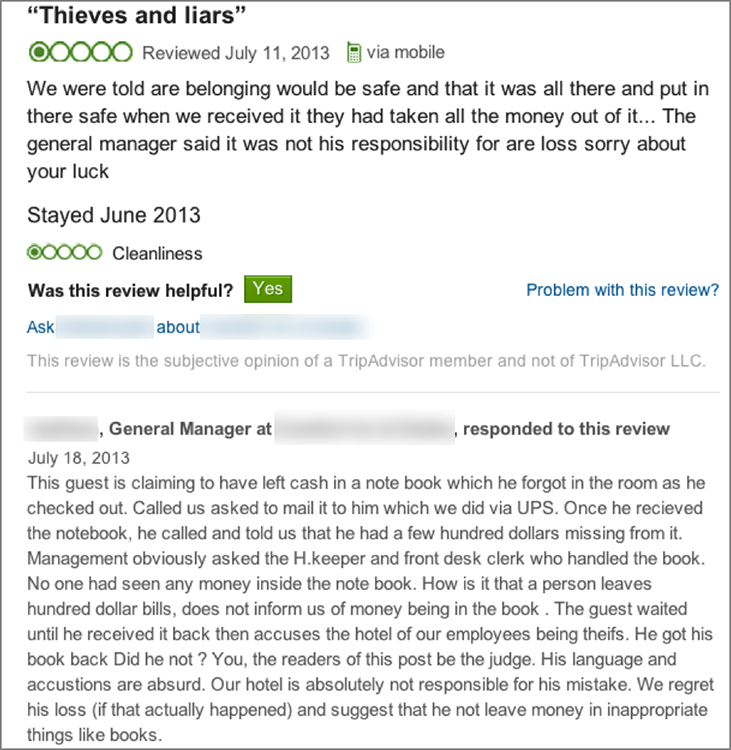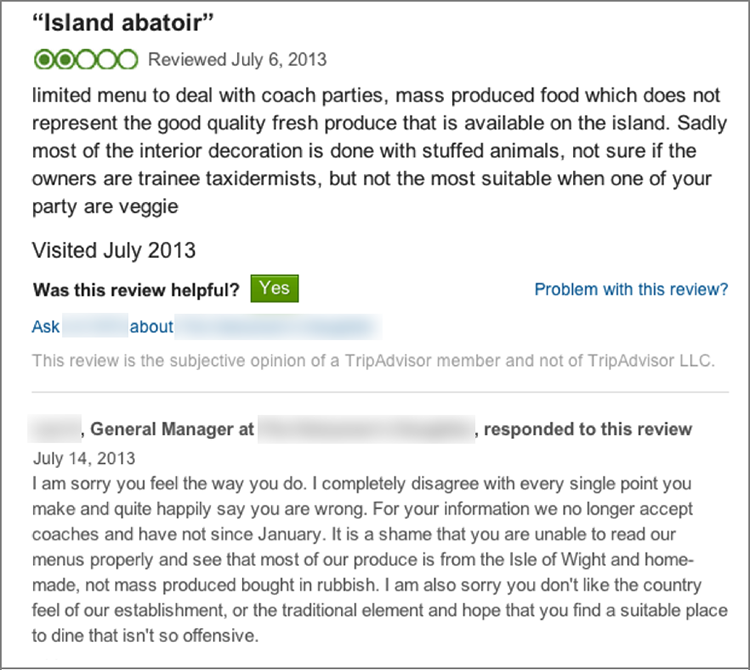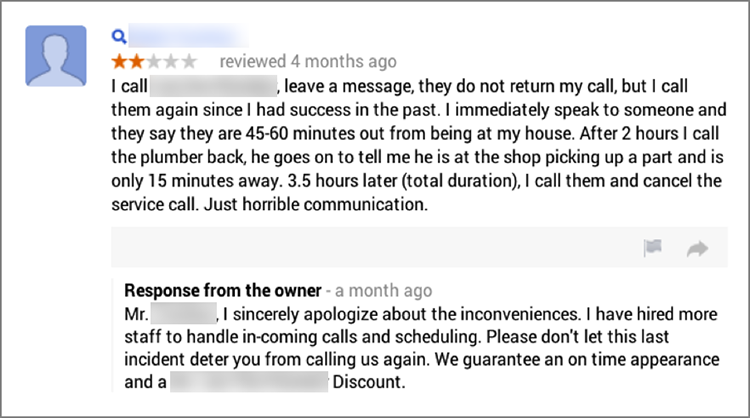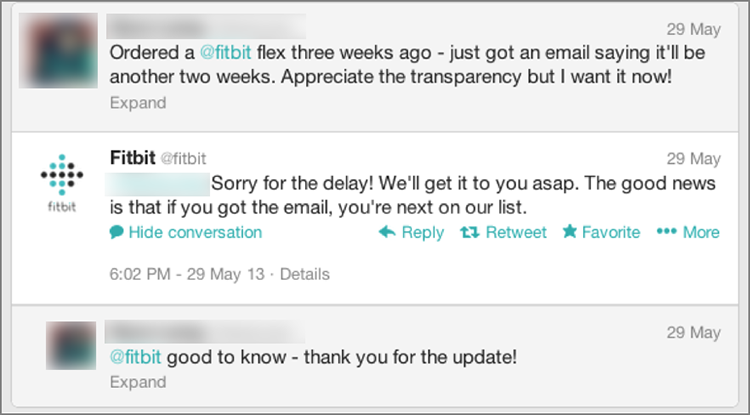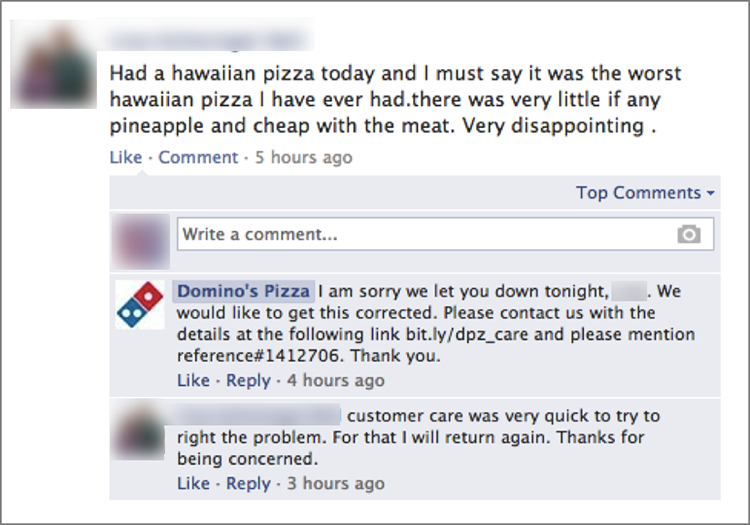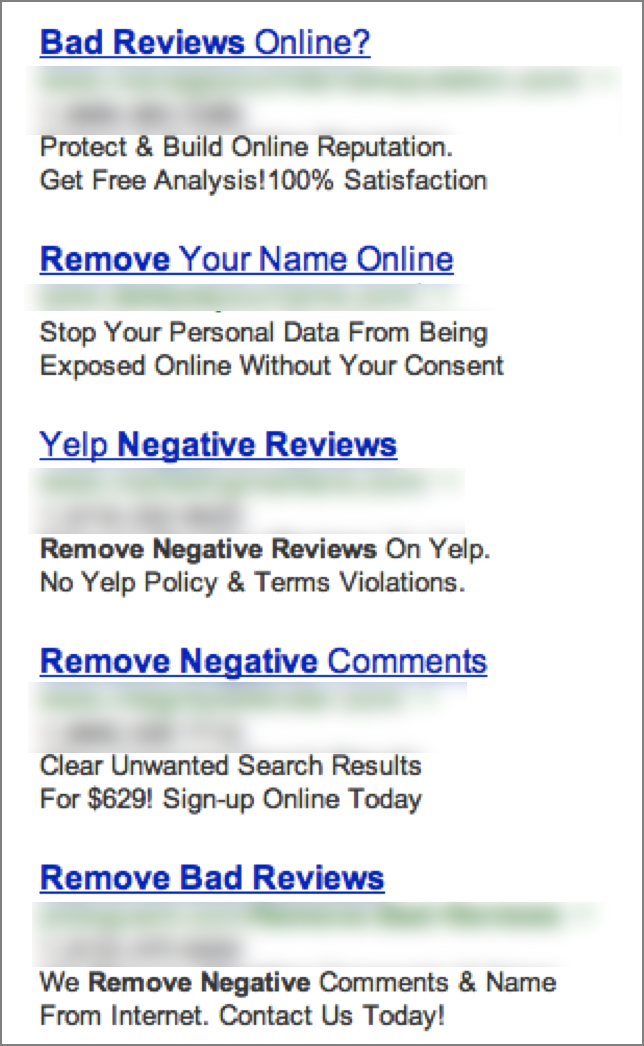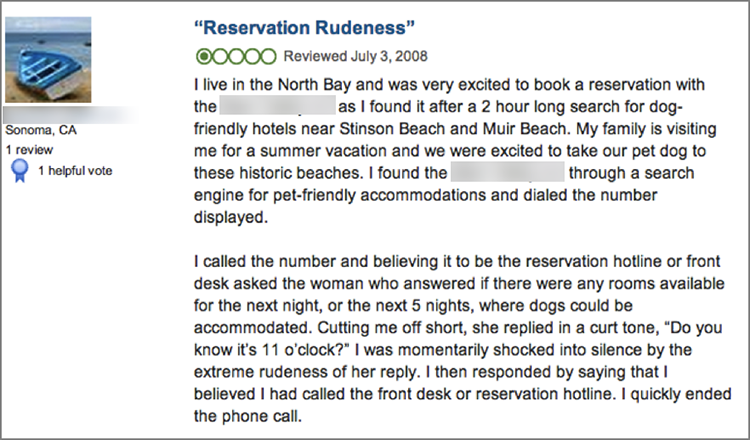Chapter 7
Navigating Negative Reviews
When a bad review enters your life, you may find little comfort in the studies and statistics showing that negative reviews are sometimes helpful to your business. You may not be particularly swayed by arguments about the intelligence and depth of judgment of your prospective customers who read those negative reviews. You just want it to disappear.
Bad reviews happen, even to exemplary businesses. Although you should have no illusions about preventing every possible negative review or removing those that have made it into the public eye, you can minimize damage by adopting a calm, thoughtful attitude and employing the strategies discussed in this chapter.
In this chapter:
- Discouraging negative reviews
- Responding to negative reviews
- Redress and removal
If there’s anything that captures the attention of businesses, it’s negative online reviews. As one business manager told us, “I’m getting stomachaches and losing sleep over these reviews.” An in-person criticism or dispute usually has few witnesses and disappears into thin air within minutes. In contrast, a thrashing on a prominent online review site can be seen by thousands and haunt a business for years to come.
At the other end of the spectrum from the business that dwells on its negative reviews, some businesses react to online disapproval by tuning out reviews altogether. We recommend a healthy middle ground. Your most important action relating to negative reviews is to pay attention to them and value the feedback they can bring. We set you on the road to learning from your reviews in Chapter 4, “Monitoring and Learning from Your Reviews,” and we hope you took that advice to heart. Here, find strategies for minimizing negative reviews and responding to those you do receive.
Discouraging Negative Reviews
Of course we love ’em, but customers can be perplexing sometimes. When we encountered our first one-star review several years ago (by a reviewer who stated that he never even read our book!), our editor told us simply but not unkindly, “There’ll always be chuckleheads out there.”
Sometimes it’s just that simple. In this world, there are a number of people who are impossible to please, unreasonable, impenetrable in their chuckleheadedness. Other times, the problem lies with you or your team. An error is committed, or a corporate culture is too broken to address problems or meet expectations, and customer satisfaction goes out the window. And in between those extremes there are endless scenarios playing out between customers and businesses, some of which will result in negative reviews.
Most of the time, negative reviews are written by reasonable people. In Chapter 3, “Understanding Reviewers and Reviews,” we acquainted you with some of the triggers that can result in a customer leaving a negative review, and we’re guessing you can identify with all of them, whether as a business owner or through your own experiences as a customer. These triggers include a particularly bad customer experience, an experience that did not align with the expectations that the customer held prior to the purchase, a lack of other communication channels to express dissatisfaction, and problems that go unresolved even after the customer seeks a fix.

There is a difference between companies that accrue a few stinging reviews in a predominantly positive collection and companies that are actually doing an awful job. If your company repeatedly fails to meet the expectations of your customers, you don’t have a review problem, you have a business problem, and fixing that needs to be your first priority.
But you’re reading this book for advice, not scolding, so let’s move on with some tips for discouraging bad reviews.
Check In With Customers
In Chapter 5, “How to Get More Reviews,” we discussed the multitude of ways you can encourage customers to write reviews for your business. But don’t miss out on the usefulness of customer feedback outside of the review venues and during all points of the customer interaction. If you connect with your customers regularly to understand how they feel about what you do for them, you may find opportunities to correct existing problems for dissatisfied customers, improve the experience for future customers, and eliminate conditions that can generate negative reviews.
Take every opportunity. You can ask your customers “How’s it going?” at any time during the service life cycle. Comment cards, feedback links on your website, or a friendly owner-to-customer chat are some ways to give your customers the chance to do you the favor of telling you directly how you can improve your business and avoid negative reviews. One small business we know was advised by a consultant to pose this question to its customers in-person at the completion of services: “If you were going to rate us on Yelp today, would you give us five stars?” See
Figure 7-1 for an example of an email that Care.com sends soon after a customer begins using the service.
Integrate feedback into your postsale process. Online reviews expert Mike Blumenthal told us he thinks all businesses should get in the habit of following up with customers after the sale to catch and correct any snafus that might have occurred without their knowledge. Mike says, “You need to follow up with every customer. This is the best opportunity to prevent the negative review. From my standpoint the sale isn’t done until that piece is done.”
Use internal surveys first. If you’re in serious self-improvement mode, it may be better to direct your requests toward getting customers to complete surveys instead of writing online reviews. We spoke with Rick Berry, founder of Demandforce, who strongly encourages businesses to use internal customer satisfaction surveys before they put efforts into requesting reviews. He told us, “I highly recommend any business start off with internal surveys. The best way to improve your reputation is to ask your customers for feedback and make those changes. That’s the cure. You can have plenty of medicine to treat the symptoms, but that’s the cure.”
Energetically checking in with your customers is a good way to prevent an annoyed customer from evolving into an angry ex-customer who may even kick off an online reputation crisis.
Provide Nonreview Paths for Common Complaints
Are there certain points in your customer’s experience where there is a higher risk of dissatisfaction? If you anticipate these potential pain points and provide a direct path to communicate with your customer service, you may stave off a public negative review. One no-brainer is to make sure that your transactional emails—the ones that explain that an order was received or a shipment is on the way—provide a link for comments or support, as seen in this example from Sports Chalet:
Any time you ask for a review, it makes sense to remind customers that you’re listening and provide an alternate path for them to lodge complaints. Figure 7-2 shows a page created by a landscaping service using the review-gathering tool Grade.us. This tool, available at https://about.grade.us/, lets businesses build a simple web page asking customers to write reviews, and it can include a Contact Us link to give dissatisfied customers the opportunity to straighten out any problems before reviewing.
Set Realistic Expectations
Sometimes, elements outside of your control can draw negative reviews. These may be temporary but unavoidable inconveniences such as renovation construction for a brick-and-mortar business or shipping or manufacturing delays for an online merchant. Or it may be a question of some customers being a better fit than others: Perhaps there’s something about your business or product that most customers like but that rubs some people the wrong way. Use whatever channels of communication you can to make sure that customers won’t be surprised when they encounter the temporary inconvenience or the love-it-or-hate-it factor that you’re not willing or able to change. In the following example, a restaurant uses its OpenTable confirmation message to prepare customers for the fact that they may not have a choice of indoor or outdoor seating.
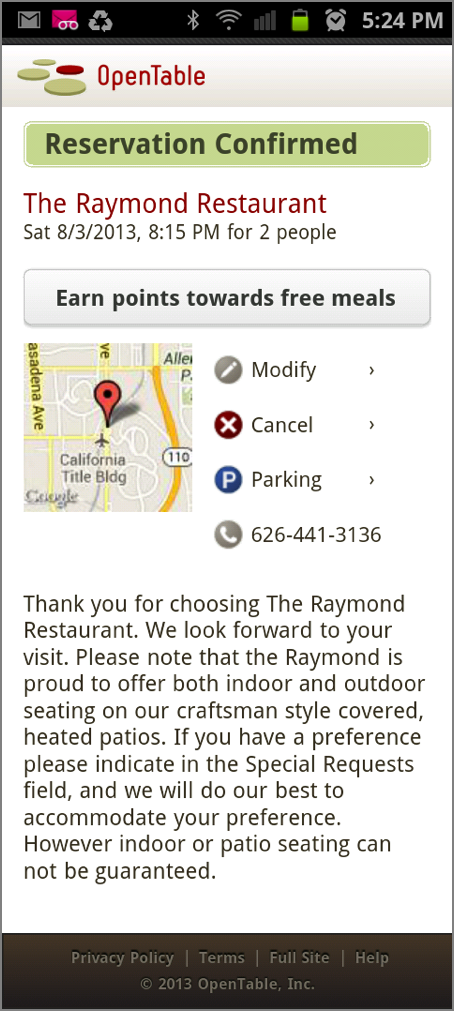
Here’s another example: Knowing that holiday shipping is a common source of consumer stress and bad reviews, many online retailers state their ordering deadlines up front for holiday delivery. Macys.com gets this right; its holiday shipping deadlines can be seen here: www.macys.com/hdayShipping.jsp. If you know you’re having temporary shipping delays or other flaws in service, let customers know via every possible communication channel.
You can also gently manage customer expectations with carefully crafted responses to negative reviews. A manager response stating “We’re sorry that we were not able to provide you with a refund of the deposit” or “We’re sorry that we cannot offer a delivery window of less than four hours” will help future customers know what to expect from your business. Read on for guidance on response-writing later in this chapter.
Broadcast Your Willingness to Listen and to Correct Issues
Some experts believe that if you send the message that you listen to your customers, they will be more likely to sidestep writing a negative review and instead contact your business directly. Here are some ways to communicate that your business is all ears:
- Respond publicly to your reviews, especially the negative ones. One review industry insider suggested to us that public responses to all reviews can reduce the number of negative reviews—or at least make them less vicious. Perhaps this is because it’s easier for a reviewer to lash out at a faceless business than at a listening, human representative.
- Make it easy to find your contact information and social media channels on all customer correspondences.
- Add a prominent feedback link on your website.
- If you’ve made improvements to your business based on customer feedback, mention it in your email newsletter or website. See Figure 7-3 for an example. You can even post a notice on the wall of your brick-and-mortar establishment.
- Don’t leave your social media commenters hanging! Read and respond to tweets, YouTube comments, and Facebook posts to your page.
Create a Process for Learning from Negative Feedback
We’ve met plenty of business owners who receive negative feedback, feel bad, and stop there. But it’s easier on your psyche, maybe even empowering, if you have a plan for parsing out the actionable information and talking through this information with staffers who can make a change. For some businesses, customer reviews are not just report cards—they are welcome opportunities for learning. Read your reviews with an eye toward identifying useful insights and finding meaningful patterns. You don’t have to slavishly make a change over every bit of customer sentiment, but be as objective as you can and look for ideas that deserve attention. Constructive criticism can be found in both angry rants and glowing reviews.
Make it a process, not just a reaction. Think about how you can create a repeatable system for using customer feedback to improve your business. Can you make time during your regular staff meetings or send out a regular email with review highlights? If you integrate these discussions into your standard internal communications, you won’t only be hashing through the negative reviews; you’ll also have an opportunity to give your staff a pat on the back when positive feedback comes your way.
Introduce accountability. Whether or not you have a formal customer relationship management process, you can treat reviews like trouble tickets that can be opened, closed, and routed to an appropriate staffer to address the problem or follow up with the reviewer. Determine who on your staff should assign the issues, what type of feedback should be routed to which staffers, and how you’ll know when the ticket is resolved, for example, when the reviewer receives a response, or when a fixable issue is corrected.
Chapter 4 provides more information on how to improve your business with feedback from your online reviews.
The Tragedy of a Five-Star Product with One-Star Customer Service
Even excellent products can get poor reviews if customer service is not up to par.
Peg Robin owns Robin’s Way, a small business selling pricey custom-made gifts (name and business details have been changed). Customers adore her creations and give extremely positive feedback on the quality of her work. Business is seasonal: Robin’s Way brings in about 80% of its yearly revenue in the months between October and January, and during these busy months, Peg is stretched to the limit—and beyond.
A few years ago, the business’s online reputation took some major hits. Peg confesses that customer service suffered around the holidays: “I didn’t have time to do everything, so I focused on getting orders out the door. I convinced myself that a good enough product would make up for a late delivery.” With Peg focusing on production, emails went unanswered. Making matters worse, the dropped emails were often from the most difficult and demanding customers, who were also the most likely to complain online: “When I look through my inbox, some of the emails look like they’re going to take a long time to answer. If people are getting prickly, as busy as I am, I just push those emails away!”
Some customers began to complain publicly on the business’s Facebook page when they were not able to get a response via email, and these complaints multiplied with “me too” replies. Peg knew she had to make a change when an unhappy customer wrote a blog post: “He compared my work to a competitor’s. Even though he admitted my products were better, he gave me an F on customer service and recommended the other business!” Peg realized that no matter how good her products were, by the time they arrived on her customers’ doorsteps, the damage was already done.
Peg’s challenges illustrate some universal truths of businesses with poor customer service:
- The high quality of your offering is not enough to overcome your service problems.
- Ignoring complaints does not make them go away. Rather, it can intensify the problem.
- Customers will post reviews whether or not you are looking, so you may as well monitor them so that you can fix problems before they snowball into a reputation concern or a significant loss of potential revenue.
Peg realized that she needed to make a change, so she forced herself to accept the hard truths delivered from multiple channels of customer feedback. Not surprisingly, she found that most complaints were about poor communication and a long wait for delivery. Peg listened, thought hard, and made some changes:
- She raised her prices and reduced the number of orders she takes in the busy season. “I shut off my online store whenever my backlog gets too high. I get fewer orders, but the revenue is the same, and the average customer wait time is reduced by about two weeks.”
- With time freed up by a reduced production load, Peg can make sure every email is answered in a timely manner—especially those from the demanding customers she used to avoid.
- Peg sends emails proactively to every customer, keeping them posted on their order status and giving them the opportunity to get in touch. She didn’t have the funds to upgrade her site’s basic e-commerce setup, so she sends these emails manually. Keeping communication channels open means people no longer feel the need to seek redress on Facebook.
Now, a few seasons later, the negative posts on Facebook are a long scroll downscreen, and current feedback is positive. Best of all, after living in fear of online reviews for years, Peg is ready for the next step: reaching out and asking all of her customers to review the business online.
Responding to Negative Reviews
Responding to negative reviews is an important part of your review management process. Done right, your response will show that you’re listening and you care about your customers’ opinions and satisfaction. It will give you the opportunity to set the record straight, clear up confusion, humanize your business, and demonstrate your competent handling of a tough situation. It may even allow you to sway the opinion of an unhappy customer. In 2013, Wakefield Research on responses to product reviews found that “[s]hopper intent to purchase doubles when seeing a brand’s response to a negative review versus a negative review by itself.” But done incorrectly, a review response can do more damage to your business than the original review ever could.
As an aid in your efforts to get your responses right, we’ll start you off with this mantra, adapted from advice given us by Mike Blumenthal:
I am not writing this just for the reviewer. Above all, I’m writing for everyone else who will see this review.
We believe this simple touchstone is the key to making your review responses the best they can be. Write it on a sticky note if you must, but don’t lose sight of it as you go.
Before You Respond
You’ve been hit with a negative review, which feels—as Yelp describes it—“like a punch in the gut.” You may be hurt and feeling an urge to retaliate. Before you strap on your brass knuckles, read these guidelines to make sure your response is a help and not a harm.
Take it slow. Every review venue representative that we talked to about negative reviews offered the opinion that business owners should take some time to get into a calm state of mind before responding to reviews. Many specifically suggested waiting until the next day. It’s natural to want to respond rapidly to a negative review, especially one that is unfair or factually incorrect. But writing a response in the heat of the moment would be a mistake.
If you respond while you are angry or emotional, your writing is likely to be defensive or aggressive and not portray your business in the best possible light. Take a breath, take a walk, and remember your mantra: Your intended audience is potential customers who will see this review. As a rule of thumb, if the thought of saying “Thank you for your feedback” makes you sick to your stomach, you’re not ready to respond.
Know the rules. Review venues have various rules and guidelines for review responses that you should follow. For example, TripAdvisor will not post a response containing personal insults, promotional materials, or ALL CAPS, among other offenses. ResellerRatings has a strict policy against asking a reviewer to change their rating. Google requires you to comply with the same content guidelines as reviewers do, restricting nudity, hate speech, impersonation, and more, and also advises business responders to “Be Nice.” We hope we don’t need to tell you that profanity is strictly verboten! Find more rules, along with other tips and suggestions here:
Google+ Local:
https://support.google.com/places/answer/184271
Yelp:
https://biz.yelp.com/support/responding_to_reviews
TripAdvisor:
www.tripadvisor.com/pages/management_response.html
Angie’s List:
http://support.business.angieslist.com/app/answers/detail/a_id/111/~/responding-to-reviews-on-angies-list
Bazaarvoice:
http://blog.bazaarvoice.com/2013/06/05/spin-gold-from-poor-reviews-responding-to-feedback-wins-new-customers/
Decide who replies. Who in your organization is the best suited to respond to a negative review? This may not be an emotionally invested small business owner, but it also probably shouldn’t be an intern who can’t speak for the business. Your responder should be someone with authority over the issues and concerns your reviewers are writing about—and a temperament that will allow them to keep a cool head. You may even want to require more than one person to sign off on responses or bring in outside writing help to craft your response. One business we spoke with had an exemplary process for writing responses. A manager with responsibility for on-the-ground operations handled both positive and negative review responses on a daily basis, putting his head together with his boss for any tricky or potentially controversial questions.
Get the access you need. To respond to a review, you’ll need to claim your business listing or set up the applicable merchant account. Some sites require more than this: As you learned in Chapter 6, “Review Venues: Need-to-Know Tips for Your Action Plan,” Yelp requires a clear personal photo in the business owner’s profile.
Know when not to respond. Reviews that cross the line from criticism to incoherence may not require a response. If a review uses inappropriate language or is threatening, spammy, delusional, or personally insulting, you might be able to have it removed, as described later in this chapter. If you suspect a review is fake, you should flag it and wait a few days before responding—and check the criteria in the section “Redress and Removal,” later in this chapter, to see if any of them fit. On Yelp in particular, it’s not uncommon for reviews to be filtered several days after they are posted. If you choose to respond to a review that you think is fake, read on for tips on building your review response.
Posts on complaint sites such as Pissed Consumer and Ripoff Report may require special handling. Internet attorney Kenton Hutcherson suggested to us that businesses should not post responses or rebuttals on these sites. According to Kenton, writing a business response generates more links to the page and adds content to it, which may increase its search engine presence. And your response could trigger additional complaints, fueling the flames of negativity.
Public and Private Responses
As a general rule, negative business reviews on sites that matter to you should get a public response. Leaving a negative review publicly unanswered inherently gives the last word to your detractor.
Some review venues allow business owners to choose whether to reply to a review publicly or privately. Many businesses, given the opportunity, will first reach out privately and try to resolve the problem directly with the reviewer. It’s an effective tactic. The 2011 Retailer Consumer Report by Harris Interactive found that of negative reviewers who were contacted by the business, over a third deleted their original negative review, another third posted a positive review, and 18% became loyal customers. We’ve heard the same thing from several businesses: Reviewers will sometimes change or even remove their review after the business reaches out with a polite apology and an effort to make things right.
The decision to respond privately should be made on a case-by-case basis. We think an initial private response is appropriate when all of the following criteria apply:
- You believe that the review is real.
- Based on your assessment of the reviewer’s attitude and tone, he or she does not appear extremely angry or vengeful toward your business. Some reviewers are just looking to unload their bushel of hate and are clearly not good candidates for any kind of dialogue. For them, it’s best to stick to a level-headed public-facing response.
- You think there’s a chance that you can clear up the problem, either with a straight-up apology, an explanation, or some form of restitution.
- The review venue allows it.
Private responses may also be the better option for healthcare practitioners whose public response is limited due to confidentiality considerations. But you should never divulge any potentially sensitive information in your response.
It may seem that your mantra, “I am not writing this just for the reviewer. Above all, I’m writing for everyone else who will see this review,” doesn’t apply to private responses, but in fact, it does. Anything you write to a reviewer can be cut and pasted into a public forum, so you need to keep future potential customers in mind for every aspect of these conversations. Be prepared to see your words quoted back to you, as in this example:

Recovering from Bad Reviews: Advice from a Yelp Staffer
We asked Morgan Remmers, Yelp’s Manager of Local Business Outreach, how a business can recover from a glut of negative reviews. She told us about a process that she likes to share with business owners. “I’ve seen this work for businesses,” she says.
The prerequisite for this approach is to absorb the criticism with an open mind, which is advice that is echoed by many review industry insiders we’ve spoken with. In Morgan’s scenario, before getting started on reputation repair, you should not be in a state of denial but rather “You have acknowledged and accepted that this is consistently being said about you.”
After that, it’s a two-step process.
The first step is to identify the common themes that you find in your negative reviews and respond publicly to a few representative complaints. “There’s usually two or three consistent gripes,” says Morgan. “Identify three to five reviews that are addressing different gripes, and respond to those handful of reviews publicly.” What makes a good response? Keep it professional. “Articulate in the best, most diplomatic way possible how you are going to change for the better.”
Explaining that you understand there’s a problem and describing what is being done to address it may help you mend fences with your disgruntled customer, and it also sends a message to anyone landing on your business page that your business listens to its customers. Morgan adds, “It also doesn’t hurt to private message consumers who have similar sentiments.”
The second step is to take a look at how you can improve your business page on Yelp. Morgan says, “Make sure that [you] aren’t shying away from plugging in the content that you can—accolades, business information, Yelp Deals, check-in offers.” According to Morgan, this is the time to think about “opening yourself to any opportunity to get more consumers in the door.” Morgan suggests Yelp Deals as an attractive option. “When a business has a rating that is so-so, that Yelp Deal might make a consumer give them the benefit of the doubt.”
Thinking about new customer acquisition along with reputation control makes a lot of sense to us. You can’t control the customer reviews on your Yelp listing, but by making sure that your business listing represents you in the best light, you’re controlling the information that you can and sending signals that you’re a trusted, credible, and appealing business to counterbalance some of the negative sentiment. These principles are not just true for Yelp; they can be applied to any review venue that gives you some control over the content of your business listing.
Building Your Response
The best business responses to negative reviews tend to contain the same ingredients. Here are some important dos and don’ts to keep in mind when you write your public or private response:
- Thank the reviewer for their feedback. Do not allow a response to be posted without the words “Thank you” in it!
- Identify your role in the business. For maximum credibility, it’s best to identify yourself by name. Ideally, the person responding should have direct authority over the issues the negative review brings up.
- When the reviewer has a valid complaint about a misstep made by your company, apologize directly for the problem they suffered. Be mindful of how you express apologies: The passively worded “We apologize that the wrong item was shipped in your order” can come off as guarded and insincere. For a more believable and constructive apology, name the problem and accept responsibility, as in, “We’re sorry we messed up your order.” If this feels difficult, you can ease into this apology by describing your ideal scenario first, for example: “We strive to make every service call on time, and I am so sorry to hear that we did not meet our goal.” For complaints that express an opinion instead of pointing out an error, such as “The room was ugly” or “The products are overpriced,” avoid non-apologies like this one: “I’m sorry you feel that way.” Try the humbler alternative, “I’m sorry we did not live up to your expectations.”
- Do not get defensive, make excuses, or argue. If you lose your cool, it will not reflect well on you for future readers. As Angie’s List says, “Attack the issue, not the text.”
- Your instinct might be to ask clarifying questions, or to try to open a dialogue about how the reviewer thinks things could be improved in the future. This may work well in a face-to-face conversation or private replies, but it is impractical on most review venues, which do not allow threaded discussions. You can absolutely encourage a reviewer to contact you to fix unresolved problems, but don’t let questions dominate your response. If you do not receive answers, this could give the impression that you have a number of open issues hanging around.
- Correct any factual errors using simple language and without placing blame.
- If you are dealing with a false accusation, you will need to work up every ounce of diplomacy and Zen-like detachment you can muster before responding. Mike Blumenthal offers a great example of a dentist who takes the high road when responding to an accusation of improper conduct. The dentist describes the standards that he follows, and invites concerned readers to refer to his accolades and positive reviews. He does not call the reviewer a liar—and in fact does not address the reviewer directly at all. Rather, he says, “My staff and I felt forced to attempt to inquire into the identity of this reviewer and, unfortunately, had to conclude that this very hurtful review is the result of a personal conflict.” Read more at:
- When a review contains a mix of positive and negative commentary, be sure to acknowledge the positive comments. You don’t want your prospective customers to dwell on the negative, so you shouldn’t either.
- Be real. Use your response as an opportunity to put a human face on your business.
- Describe specifically what you are doing to improve the situation. Although this may seem impossible if you don’t think your business did anything wrong, you can always at least say you are keeping this feedback in mind for the future.
- Provide an email or phone contact where the reviewer can reach you. Sure, this information might be just a few inches above the review on your business listing page, but adding it to your response conveys a real willingness to connect.
- If you have already reached out to the reviewer privately, mention that in your public response. This communicates to anyone reading that you are taking steps to resolve the problem.
- If you can do so subtly and appropriately, describe the great aspects of your business in your response, for example, “We’re sorry your experience prior to the massage was so unpleasant, but we hope our expert massage therapist was able to help you wash away some of the stress.” Or gently point out reasons to give your business another try, for example, “We’re proud to have 20 licensed massage therapists. Next time I’ll be happy to personally help you pick the right one for you.”
Keep your mantra top-of-mind while writing responses. Your primary audience here is your future potential customer who needs to see that you handled this exchange professionally.
Exercise: Rate Responses to Negative Reviews
The best way to get a feel for effective responses to negative reviews is to sift through your favorite review venue and read as many business responses as you can. Spending even an hour doing this will give you a solid feel for what sincerity looks like, what feels trite, and the difference between professionalism and pedantry. As you read, you’ll likely run into several responses that come off as hotheaded because they were dashed off without that critical cooling-off period.
You can find review responses by clicking randomly through review sites, or you can try some advanced Google searches to get you there faster. To do this, you just need to know two little tricks:
- The Google <site:> search command causes Google to return pages from only the site that you specify. For example, start your Google search with <site:www.yelp.com> to tell Google to return only pages from Yelp. (Make sure there is no space between the colon and the name of the site.)
- Add the standard text that goes along with an owner response on the review site of your choice to your search query to see pages containing review responses. Here’s the standard text from a few popular review sites:
Venue
| Text (be sure to put it in quotes in your Google search)
|
Google+
| “Response from the owner”
|
Yelp
| “Comment from”
|
TripAdvisor
| “This response is the subjective opinion of the management representative”
|
Here are a few example searches:
Now, let’s go through and grade a few responses to some particularly tricky negative reviews. For this exercise, you’ll award points for the following good qualities:
- The response addresses the complaint directly.
- The response is professional and polite.
- The response states what is being done to address the problem.
- The response gives the reader a reason to like, trust, or try the business despite the negative review.
Negative Review for a Car Rental Business
What makes it tricky: This review doesn’t stick to describing just poor service; it contains specific details that raise questions about the ethics and trustworthiness of the business.
We give this response 2.5 out of 4. The response is polite and makes an attempt at addressing the complaint directly by offering to look into it further. However, the response leaves the ball in the reviewer’s court. There is no reassurance that this type of behavior is against company policy or that steps will be taken to correct the issue if the reviewer does not respond. Thus it’s missing important trust and likability signals for the prospective customers who read it.
Negative Review for a Tour Guide
What makes it tricky: This review has no constructive criticism to work with and seems to be more of an indication of a bad fit between customer and business rather than a flaw with the business.
We’ll add to the zeroes by giving this response 0 out of 4. This response conveys the frustration that a business owner feels when a reviewer callously trashes the business. With the comment, “Out of well over 100,000 visitors you are the only one to say that,” the response almost makes the case for why others should give the business a try, but falls short and instead becomes accusatory. Wouldn’t a simple, “We have had over 100,000 visitors, and the feedback we get is overwhelmingly positive. I’m so sorry this wasn’t your favorite experience!” have been better?
Because the review has so little information, it lacks credibility and might have been brushed off by readers if it weren’t for the owner’s petulant display. It’s better to leave no response than to leave an angry or sarcastic one.
Negative Review for a Hotel
What makes it tricky: The reviewer delivers a serious accusation that must be addressed, but it is the management’s word versus the guest’s word.
By our count, this response gets 3 out of 4, but the score is less important here, because this is no ordinary situation. It’s important to apologize for a lapse in service, but no one should feel pressured to apologize for a crime that they do not believe was committed. The response maintains a measure of professionalism while providing the hotel’s side of the story and defending its integrity. We like that the general manager addresses the reader and not the reviewer in this response, and we think the directness of “You, the readers of this post be the judge” is appropriate and effective.
Negative Review for a Restaurant
What makes it tricky: The review uses inflammatory language and contains no glimmer of positivity.
So close! This response has the basic ingredients necessary for a 4 out of 4, but the general manager’s tone ruins it. Would a cooling-off period of just a few hours have changed this snippy response into something that paints a better picture of the business? Here’s our proposed rewrite that keeps all of the information while removing the hostile tone.
“I am sorry we didn’t live up to your expectations. You may be pleased to learn that we no longer accept coaches, so our menu is not a concern in that regard. Like you, we dislike mass-produced food, and we’re proud to say that most of our produce is from the Isle of Wight and homemade. Many of our diners say they love the country feel of our establishment or the traditional element. I’m sorry the ambience disappointed you.”
Your readers are human too, and they know how easy it is to let loose with your unfiltered opinions. Like you, they may even think the reviewer deserves to be put in his place! But smart readers—the people you want as customers—know how much effort it takes to respond to rude remarks with restraint and professionalism, and your hard work to craft even-handed responses will make a favorable impression.
Negative Review for a Plumber
What makes it tricky: The reviewer gives specific, believable details about an experience that reflects poorly on the business.
This one gets a solid 4 out of 4! With professionalism, politeness, and not a hint of defensiveness, the owner apologizes and describes steps taken to make sure the problem won’t happen again. He even closes out the comment by mentioning some good reasons to give this business a try: a guarantee and a discount. All of these factors add up to create the possibility that a reader may call this plumber despite the bad review.
Responding in Social Media
Your protocol for responding to social media comments can be slightly different from responses on review sites like Yelp and Google+ Local. On one hand, there may be less pressure, because social media commentary does not have the permanence of online reviews. On the other hand, the situation can escalate quickly if a social media comment gains a lot of visibility by shares, retweets, or upvotes. Responding to criticism in social media requires some thinking on your feet, so consider these questions before you respond:
How visible is the comment? Did the comment come from someone with a lot of followers or influence among your target customers? Has it been reposted, retweeted, or upvoted into the spotlight? There’s a bit of added complexity when a particularly visible negative comment comes your way: Your response should be published quickly, and it should probably also receive additional scrutiny from inside your organization before it’s published.
To save time when you’re in damage control mode, it’s best to have a response plan ready in advance. Creating a social media response plan can be as simple as sitting down and brainstorming as many complaints as you can think of about your company, scripting possible responses, and mapping out which types of issues should be moved to offline conversations and which types require a team effort for composing and approving responses. Additionally, make a plan with your team on how the appropriate team members will be alerted if you need to escalate a comment for a quicker response.
How can I make this better? Just like online reviews, negative social media commentary can take the form of constructive criticism, helpful suggestions, unhelpful vents, or hateful screeds. Your job is to respond politely to anything that seems genuine, help those who need help correcting an issue, and ignore or delete comments that cross the line into hate speech or profanity. Just as with online reviews, you must craft your responses with both the general public and the individual commenter in mind. You may have to do it a little more quickly, and with fewer characters at your disposal, than you would on a review site. Transparency and honesty are always key. If the issue is complex, an initial soft response like, “We’re sorry you’re having this problem! We’re looking into it” or “I’m so sorry you had a bad experience. Please contact me at [email address or phone] to discuss” may be effective in communicating to both the commenter and the public that you listen and care about your customers. See
Figure 7-4 for an example of a comment on Twitter that was handled nicely by Fitbit’s social media team.
Figure 7-5 shows an example from the Domino’s Pizza Facebook page. Although Domino’s responses lean toward the formulaic, they do a good job of ensuring that no comment is ignored or forgotten.
Is a response necessary? Maybe you’ve heard the phrase “Don’t feed the trolls.” Sometimes social media comments are posted with the sole objective of provoking, annoying, or stirring up controversy, and these can often be left alone, especially if the comment has not achieved a significant level of visibility and is blatantly inflammatory, puerile, or obnoxious. Another scenario that might not require a response would be two people interacting with no expectation of a response from your business. If you’re not sure whether a response is appropriate, take a minute to view the commenter’s profile and get an understanding of their past interactions and their follower or friend count. This may provide some insight into whether they are worth your precious response time—or whether they are a real person.
Staying positive and keeping a cool head are imperative, and honesty and transparency are always key in social media communications.
Most Online Reviews are Positive
If there’s one piece of advice you take away from this book, we hope it’s this: You can’t avoid getting reviews online, so pay attention to them and get involved in the conversation. If you’ve been avoiding cultivating online reviews because you’re afraid that you’ll be flooded with negative ones, Matt McGee, Editor-in-Chief of Marketingland.com, has some news that you should find heartening: The majority of online reviews are positive. Here are the statistics as reported by major review venues:
- Yelp reports that 79% of reviews on its site are 3-star or higher.
- A manager at TripAdvisor was quoted in 2012 as stating that three-quarters of all TripAdvisor reviews have ratings of “very good” or “excellent.”
- According to Bazaarvoice’s Conversation Index from June 2012, “Overall, 82 percent of all consumer opinions are positive.”
Perhaps you’ve been thinking that only angry people write reviews. That just isn’t the case—in fact, as you learned in Chapter 3, both a very good and a very bad experience can trigger a review. So why do so many businesses think that only customers with an axe to grind write reviews? It may be partly because of hype coming from reputation management companies. As Matt says: “Some of the voices that are emphasizing the negative reviews have a stake in getting business owners to be aware of the services they offer.” Also, negative reviews tend to get more attention, both from business owners and from customers. “Negative reviews are the ones that sting.”
For most businesses, the majority of customers are happy. If you engage your customers in an open dialogue about your business and cultivate reviews from a representative sample of your clientele, we’re confident you’ll find good things happening in your online reviews.
Crisis Management
We’ll start by letting you know that a single negative review does not a reputation crisis make. Even a few negative reviews don’t constitute a crisis, as long as there are positive reviews to counterbalance them. A true reputation crisis—one in which a business’s future is genuinely threatened by negative reviews that receive a great deal of attention—is rare indeed.
Here are some factors defining a reputation crisis that demands your rapid attention:
- A negative comment has grown legs in social media, getting amplified by retweeting, reposting, or upvotes.
- Someone with a great deal of influence on the opinions of your prospective customers has said something negative about your business in a popular public forum.
- A complaint pointing out major or dangerous concerns is published in one of your top-priority review venues, or is visible in top search engine results for your company or product name.
- Multiple negative reviews are voicing the same grievance in rapid succession.
If you are experiencing an online reputation crisis, we have another mantra to add to the one we gave you previously in this chapter: Don’t make things worse.You do not want to get in an exchange that turns a single negative comment into a full-fledged embarrassment. Well-known examples include a chef reacting to a mildly negative review with harsh tweets that escalated to this doozy of a comment: “I think your [sic] a c*** and this its [sic] personal….” That will do bit more reputation damage than the original 3-star review, dontcha think? In another example, a construction company reacted to a scathing Yelp review by threatening to sue the reviewer. The reviewer updated his review to reflect this, and the whole ugly exchange made it to the front page of the hugely popular site reddit.com.
Your response will make all the difference: A 2011 study by the Altimeter Group concluded that more than three quarters of social media crises could have been diminished or averted with proper handling; in some cases, the primary catalyst was a slow or inappropriate response by the business to a negative online remark.
Most of the advice in this chapter applies to any crisis, especially the need for calm and professionalism in your responses. However, especially in high-visibility social media situations, your reaction will also need to be rapid. Focus on these qualities in your response:
- De-escalation
- Transparency
- Humility
- Contrition, if the complaint is valid
- Moving the conversation offline
You may not have time to get all the facts before you respond. It’s okay to start by just stating that you are looking into the problem.
To learn more about preventing and handling social media crises, read these articles:
Redress and Removal
What’s the best way to get a review site to take action if you’ve been the victim of a false or defamatory negative review? Even if you are clearly and demonstrably in the right, you may be surprised to learn how limited your options are. Read on for some important background on why review sites are protected and for some options for review removal that might apply to you.
Why It’s Not Easy to Sue Review Sites
When a damaging or false review is published on a review venue, some business owners want to take legal action. This is a scenario that comes up frequently enough that Yelp has “I’m considering legal action—what are my rights?” on its Common Questions page. We’re not lawyers, but even us common folk can figure this one out:
If you decide to sue a review site over the content of its reviews, it’s not likely to be a good use of your time or money.
Review sites get their legal armor from Section 230 of the Communications Decency Act (CDA), which provides extensive immunities for sites that post user-generated content. We had a conversation with Katherine Fibiger, who has an advanced degree in IP law as well as an MS in MIS, to get her explanation. She told us, “Section 230 is a powerful tool for protecting free speech. What someone would be liable for in the non-online world, they are immunized from in the online world.”
Section 230 protects websites from liability for information that is created by others and presented on the website. Katherine offers up some helpful interpretation here: “Section 230 added protection for internet service providers and users from actions against them based on content posted by third parties. The Act defines ‘interactive computer service providers’ very broadly and includes any online website or service that publishes any third-party content.” The Act has been interpreted to include search engines, moderators of discussion groups, owners of chat rooms, and review sites, among others.
Under Section 230 protections, bloggers aren’t liable for comments left by readers, search engines aren’t liable for the content of websites they display, and review sites aren’t liable for the content of reviews they show. “The Act immunizes anyone who runs a website or who acts as an intermediary.”
We wondered if there were any scenarios in which the protections of Section 230 of the CDA do not apply. Here’s what we learned:
When the Site Authors Its Own Statements Although a site can’t be held responsible for the defamatory statements of its users, the site is not protected if it writes defamatory content or edits someone else’s nondefamatory content to make it defamatory. Moderating reviews, or even making editorial judgments about what reviews to display, is not considered authorship.
When a Site Agrees to Remove Content The act of flagging or notifying a site does not make the site liable for defamatory statements, but if a website agrees to remove content and then does not comply, the site may lose its protection under Section 230. According to Katherine, “If you see a report about your business that is clearly factually incorrect, you can contact the site and ask that it be removed, and if they agree to remove it, they are responsible for removing that content.”
Certain Types of Content Katherine says, “Most speech is protected by the First Amendment in the United States, but there are exceptions to the broad coverage it affords someone posting an online review.” Here are some quotes from Katherine that we hope will provide some insight:
- On hate speech: “Hate speech is not protected speech and is never acceptable under the First Amendment, but the ISP will not be liable for posting it.”
- On copyrighted works: “If you have taken some photographs and an online reviewer claims ownership of the photos, that use is not protected—it is a copyright violation.”
- On the use of a person’s image and likeness: “If someone posts a picture of you (and you are not newsworthy or famous) then that use is prohibited by privacy laws. Similarly, private information cannot be posted by anyone.”
That’s a big legalese sandwich for you to chew on! Our intention is neither to encourage or discourage anyone’s litigious aspirations but rather to provide a little background information that will help you get a feeling for reasonable expectations.
When Can a Review Be Removed?
Uh-oh. A bad review’s got you down, and you’re hoping to get it removed from public view. If you believe what you hear from some reputation management companies, or what you see when you run your eyes over the Google search ads for “remove negative reviews” (shown in Figure 7-6), you might have the impression that getting reviews taken down is just a matter of greasing the right palms.
The reality is there’s no reputation management firm with strong enough superpowers to clear away all your negative reviews. And this is a good thing: Remember, even though you’re probably sick of reading it by now, bad reviews can have some benefits for your business, and any sort of pay-to-remove process would deeply damage both your credibility and that of the review site. While you’re resisting the kneejerk reaction to kill your bad reviews, read on to learn some scenarios when one can legitimately be snuffed out:
Removal by the Original Reviewer Most review venues give a reviewer the opportunity to remove or edit his or her review to reflect a change of heart. We’ve already described how you should respond to your negative reviews and attempt to resolve the problem. Getting a negative review taken down may be a nice side effect of your response, but you should not apply any pressure or directly ask customers to change or remove their review. Besides being uncool and potentially embarrassing to you if exposed, this is discouraged by review sites and may even violate their rules.
Violations of Review Site Rules or Guidelines You already know that review venues prohibit threats, bigotry, and profanity in reviews. Did you also know that TripAdvisor does not accept reviews of hotels if someone didn’t actually visit the property? And Yelp’s Content Guidelines suggest that reviews should include firsthand experiences, “not what you heard from your co-worker or significant other.” If you are suffering from a negative review that violates any of these guidelines, removal may be an option. Figures
7-7 and
7-8 are two examples of negative reviews that we believe could be candidates for removal.
Don’t expect a review site to take down a review just because you think it’s a pack of lies; that’s not going to happen.
But if you think a review violates site guidelines, flag that sucker! And when you flag, be sure to write a detailed explanation of how you believe the guidelines were violated.
On Your Facebook Page You have the ability to delete posts on your Facebook page, but think carefully before you use this option. If a complaint is posted on your Facebook page, do not remove it unless it contains profanity or is otherwise offensive to readers. Removing complaints sends a message that you have something to cover up, and it also provides ammunition to reputation bashers, who can then say “I complained about their product and they censored me!” Remove only the truly inappropriate comments, and for all others, stick to leaving the kinds of professional and transparent responses that we described earlier in this chapter.
On Your Website In general, website owners have a lot of control over reviews that are posted on their own sites. In Chapter 6, we mentioned that Bazaarvoice, the dominant provider of product review infrastructure for e-commerce sites, allows retailers to reject product reviews within the tool’s dashboard. The WordPress review plug-ins we’ve seen also allow this, as do the customer review modules offered with e-commerce solutions such as Volusion. This capability should only be used to remove reviews that are clearly inappropriate, and not just those that are negative or unpleasant.
Some other review-gathering tools give business owners a great deal of control over which reviews are published to their website. For example, GetFiveStars at
https://getfivestars.com is a tool that helps businesses gather reviews and allows businesses to choose which reviews to publish. We think it’s any business’s prerogative what they want to post on their own site, but if you’re only publishing positive feedback, those are testimonials, not reviews, and they should be labeled accordingly.
Review Site Arbitration If you and a reviewer have a factual disagreement, you generally can’t look to the review site for assistance. Google’s statement, “We do not arbitrate disputes and more often than not, we leave the review up,” is echoed by Yelp: “We don’t take sides when it comes to factual disputes.” TripAdvisor also does not mediate or arbitrate reviews. And an Angie’s List representative told us, “Generally speaking, if the member stands by the report, we tend to side with the member.” Of all the major review sites we have researched, Angie’s List is the only one that offers a formal arbitration process; however, their arbitration can be initiated only by the dissatisfied customer and not by the business.
It would be great if more review sites offered arbitration services for businesses, but it’s clearly much simpler for them to maintain an objective distance, framing themselves as conduits for information and not as keepers of the truth.
Blackmail Deep in the darkest, sleaziest corner of the online reviews universe lurks the review blackmailer: a customer who either demands a payment to remove a negative review or threatens to write a negative review if payment is not received. Review sites are aware of these diabolical deeds. In January 2013, TripAdvisor released a blackmail reporting tool for businesses to use “when a guest threatens to write a negative review unless a demand for a refund, upgrade, or other request is met.” To report an incident, log into your TripAdvisor management dashboard and select “Manage your Reviews > Dispute a Review”, then select “Report blackmail.” Prompt reporting of a threat may prevent the review from ever being published. On other review sites, you can post a public response and flag the review, and consider seeking a court order and Google removal as described in the following section.
Court Orders and Google Removal A nasty review will do much less damage if it doesn’t show up in Google search results. Attorney Kenton Hutcherson spends much of his time working to get false reviews taken down—not from the review sites, but from Google search results. The process involves first filing a lawsuit against the original author of the review (not against Google or the review site), and getting a court order declaring the review to be false and defamatory. Submit the court order to Google at this URL:
https://support.google.com/legal/contact/lr_courtorder?product=websearch
Within a few weeks, the page should be removed from Google’s search results.
In addition to removing pages due to a court order, Google may remove a page from search results if it contains highly sensitive personal information such as your social security number or an image of your handwritten signature. If this applies to you, start here:
https://support.google.com/websearch/troubleshooter/3111061#ts=2889054
Here’s hoping you have more positive reviews to show off than negative ones to fret about! In Chapter 8, “Showing Off and Being Found,” you’ll learn how to make your reviews more visible.
